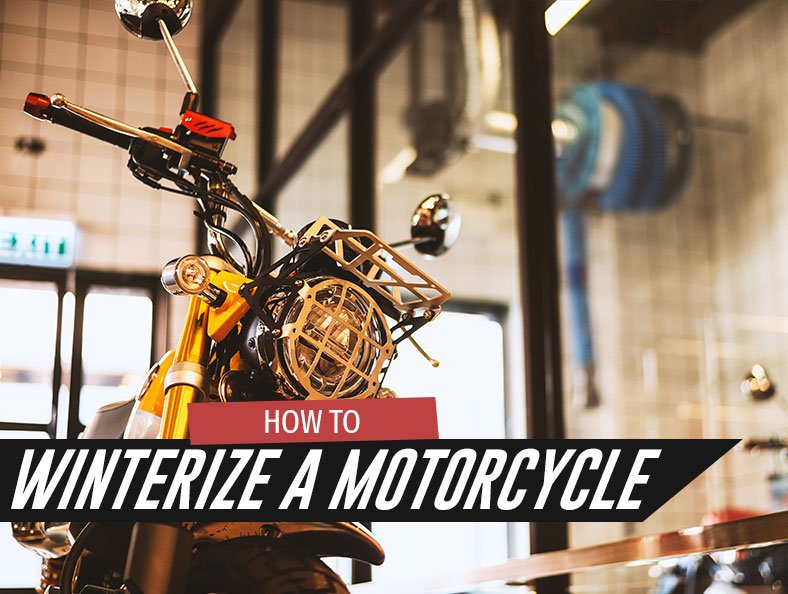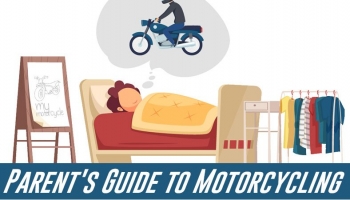Winterizing Your Motorcycle – How to Maintain and Store

Do you live in an all-season area? If you get to experience both warm and cold weather during a single year, you’re probably aware of „garage season“.
Even if you’ve just bought your bike this summer, it’s a term you’ll have to familiarize yourself with. In essence, it means it’s time you learn how to winterize your motorcycle and prepare it for the cold awaiting of the spring season.
Still, if you don’t do it properly, you’re in for a big surprise when the snow melts. To avoid this, learn how to protect your motorcycle and make sure it’s ready for the harsh temperatures.
Gather the Materials
Before you start, make sure you have all the required tools at your hands reach. This way, you’re sure to have everything and you save time by preparing it in advance.
You’ll need cleaning cloths, trickle battery charger, spark plug wrench, four to five quarts of quality oil, filter, oil can, fuel stabilizer, chain lube, WD40 spray, motorcycle cover, rubber bands, kitchen plastic wrap, and gloves.
Choose either plastic or vinyl gloves to protect your hands from the different chemicals you’ll be working with. You’ll also need a few items to clean the motorcycle before you park it away for the winter.
Thoroughly Clean the Bike
Use whatever detergent you prefer to wash your bike with. Any gentle detergent and warm water will do just fun to remove road grime and insects.
Make sure not to spray water directly into the muffler. Some parts could rust relatively quickly if they get wet but not dried properly. Baffles and air cleaner housing rust almost always in this case. If the housing rusts, it could make cycle difficult to start later on.
Wash it with your favorite detergent and rinse it well before drying. If you have one, you can use a leaf blower to dry all the crannies and nooks with ease.
To finish off, wax the motorcycle and spray all the exposed metal surfaces with some WD40.

Decide if You’ll Empty the Tank or Not
Think about if you want to empty the tank or not. You don’t have to do it, but you should decide at this point. Both methods have their setbacks since full tank adds more stress on the petcock while an empty tank might result in dried out seals.
If You Will, Change the Oil and Filter
If you decide to empty the tank, you should also change both oil (see best options) and filter. It’s recommended to have new oil sitting in the tank for a few months since it’s better than to have used in it. Plus, you don’t want to have to change oil in the spring before you take the bike on its first ride.
Use winter-weight oil such as 5W30 which would help the motorcycle start up much easier the next season. More so, if the motorcycle will sit still for four to six months, you want to protect all its parts and engine’s internals.
Should you use regular or synthetic oil? Find out.
By covering these parts with oil, you’ll prevent the moisture to gather in the engine. This often happens during the winter and skipping this step might result in rust on cylinder walls and pistons.
Read more on how often to change your oil during the rest of the year.
Remove the spark plugs and add approximately a tablespoon of oil into the holes. Turn the engine over a few times and spin the rear wheel while the bike is in gear, so the cylinder walls could coat with oil. Make sure to also replace the spark plugs.
Find the top motorcycle oil filters here.

Add a Fuel Stabilizer
You’ve probably heard that gas tanks could rust when not in use (if that’s you, we’ll walk you through how to clean your motorcycle gas tank). Another thing that could happen is for pump gas to break down and become gummy and unusable.
This happens more often than not, especially if you won’t be riding for the next four to six months.
To make sure the fuel is in a good condition even after a few months of sitting, you should consider a good fuel stabilizer. It’s also a great way to prevent rusting.
Fuel stabilizers are available at all gas stations and motorcycle shops, so you won’t have issues finding some near you. Add a good amount of stabilizer and top off the tank. When your tank is full, it will prevent the moisture from building up.
We recommend you do this on your last ride before storing the bike. Go to the gas station and do this, so the stabilizer and gas could mix together as you ride back home. By doing this, you’re making sure that the stabilizer ran through the entire fuel system.
Decide Where to Store the Bike
Think about whether you’ll store the motorcycle inside or outside. The best option would be in a heated garage where the bike would be protected for all the elements. Storing it outside is not a good idea, so if you don’t have any indoor space, check with your family and friends if they could store your bike somewhere.
See our top storage sheds here.
Pros and Cons of Storing Indoor or Outdoor
- Storing it outside when it’s raining and snowing for months could be fatal. Many things could go wrong if the bike is left in a stormy winter even if you cover it.
- Inside space is a far better idea, but make sure to use a cover nonetheless. Bikes left uncovered for months could have dust built up in several parts.

Add Lubrication
By lubing the moving parts, you keep the moisture from building up. All built up moisture could cause rusting or binding, which is why we add lube.
All parts that have to be lubed at some point should be lubed now. These are cables, fork surfaces, chain drive, controls and other pivot points.
Check Antifreeze
Check the coolant if you’re storing the bike where the temperature gets below freezing. It should have the adequate levels of anti-freeze in order to endure the harsh temperatures.
This is a critical step because water in your coolant system will freeze over the winter months. If this happens, you’ll most definitely find a cracked head in the spring.
Tend to the Battery
When batteries sit for a long time, they usually self-discharge. The best way to prevent this is to hook up a battery tender with smart technology. It monitors the charge while also preventing overcharging.
Normally, you have to pull the battery from the motorcycle so you can store it. On the other hand, a battery tender allows you to leave it in the bike for the upcoming months.
Of course, you should clean the electrodes and the corrosion if there’s any. Also, it’s a good idea to lightly coat them with oil as well.
Plug the Holes
Plugging the holes is essential in order to prevent mice and other rodents from hiding in there. They’re notorious for escaping cold in the exhaust pipes and air filters.
To prevent this from happening, you should plug the pipes and holes with an exhaust plug. If you don’t have any, you can use a simple plastic bag to stuff the air intake and the end of the exhaust.
You’re allowed to use anything to keep the mice and rodents away, but make sure to remember you’ve plugged the holes. Use bright colored bags or whatever else to mark the area.

Add Leather Protectant
If the bike features any leather parts, you should use a leather protectant on them. It will act as a cover to protect the material from suffering any damage due to harsh temperatures. Other leather components that come off such as saddlebags (see how to install them) should be stored inside.
Protect the Tires
The final step is to protect the tires (see top tires here). If you leave them sitting in the same position all winter, they’ll most likely end up with flat spots. Use simple stands to get the tires off of the ground and prevent any damage.
Here’s how to use a stand properly.
If you don’t have stands, you should at least lift the rear tire off the ground. If this isn’t an option either, you can rotate them every few weeks throughout the winter.
Also, if the bike will spend the winter on concrete, you have to put something between the floor surface and the tires. Use anything like plywood or a piece of carpet.
Conclusion
As you see, winterizing a motorcycle isn’t as hard as it might sound. It’s a process of a few steps that are fairly simple to do when planned well. For this reason, take your time and plan anything you can in advance.
Make sure to gather the materials beforehand. Also, figure out where you’ll store your motorcycle so you’re not caught mid-winter with nowhere to leave your vehicle.
All of the steps above are crucial for protecting your bike when the temperature starts dropping. So, use this article as a guide and came back to it as many times as you need.






